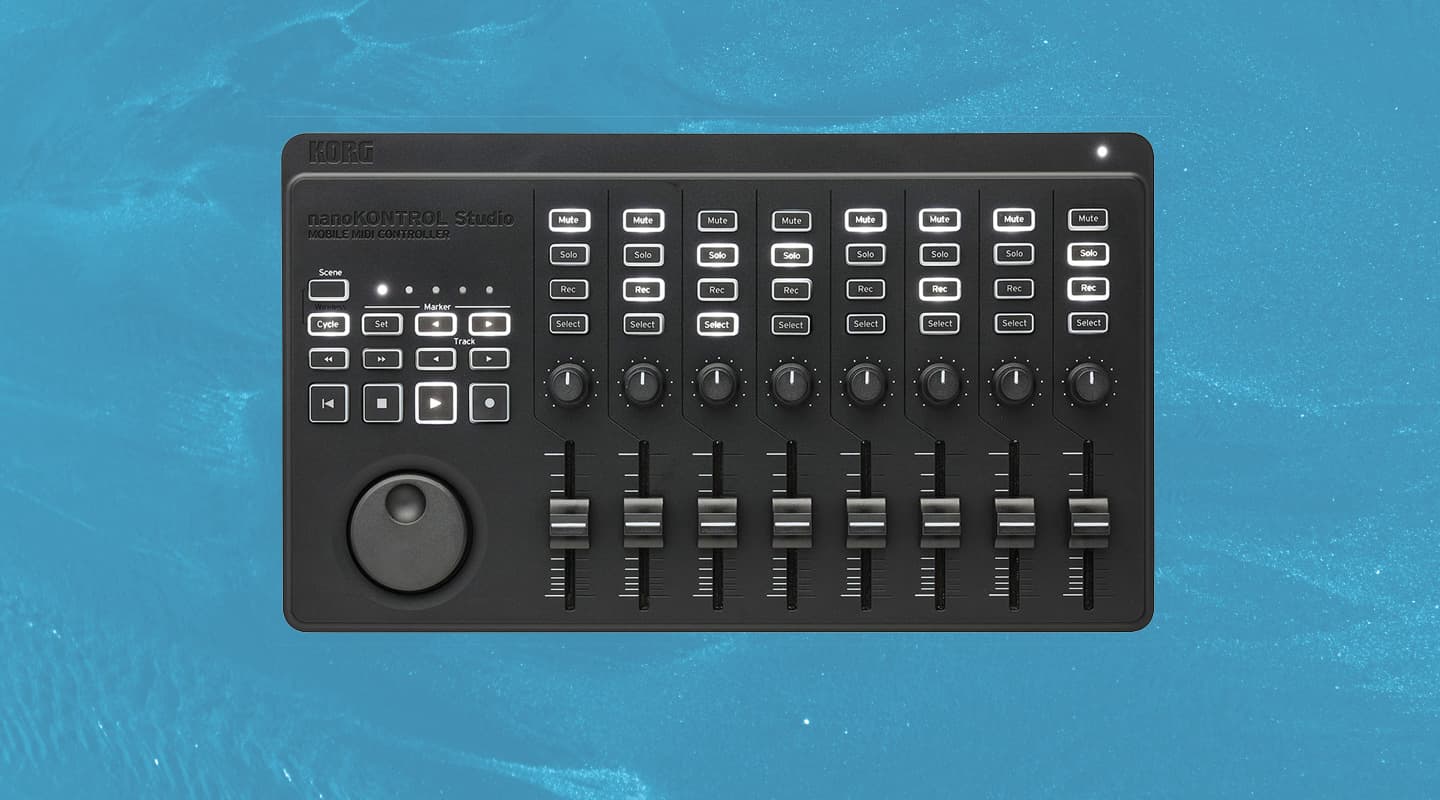
Review: Korg Nanokontrol Studio
I’m usually not a big fan of non-motorised control surfaces. The constant dance of picking up last used settings drives me nuts. As a result, I’ve never really fallen into the orbit of these devices. Recently, I was given Korg’s new NanoKontrol Studio to review. Intrigued by the miniature box, I downed some humble pie and set out to discover if the little, non-motorised controller could soften my defiant stance.
NanoKontrol Studio is a mini control surface with eight channel strips, each featuring a (non-motorised) fader, pan pot, and backlit solo/mute/select/record buttons. To the left you get your usual transport controls, plus a jog wheel and marker setting buttons. Nothing about the unit jumps out as ‘special’, except perhaps its super-slim form factor.
PORT-ABILITY
Korg’s Nano family — NanoKey, NanoKontrol and NanoPad — are all nifty portable music production tools primarily targeting the music producer on the go, and NanoKontrol Studio really amps up the mobility stakes with Bluetooth compatibility. But first, how are those faders?
One way non-motorised faders work effectively is by implementing a method of picking up their last position by forcing you to return the fader to that position before the DAW fader responds to any more input. This is typically a DAW-specific parameter; in Logic and Ableton you have to set the controller operation to ‘Pickup’, Pro Tools was a little less helpful. It stops the DAW fader jumping to the physical fader position as soon as you move it. Even with the option turned on, it can get tedious having to constantly wiggle faders to get them going, and it also reduces your mix precision as you overshoot previous level settings. If you’re not using it for critical mix applications, it can be fine.
NanoKontrol Studio has a couple of other party tricks though. Firstly, it does more than just control your DAW — you can use it to control your iOS recording apps. Secondly, it has low-latency Bluetooth connectivity for wireless control. That’s pretty fresh.
The featherweight plastic unit feels slightly toy-ish but doesn’t come across as flimsy. The jog wheel is firmly detented and the rubber buttons look and feel great in use, with the backlights fading in and out with a classy glow. The faders and knobs aren’t exactly pro, but they’re comfortably smooth, with reasonable travel for the unit’s size.
The Power switch has three positions — USB, Standby, and Battery. If you leave it on Battery even when connected via USB, it’ll lose charge. But the unit has automatic power-off when used wirelessly.
Detailed instructions are provided to get it running with most common DAWs. If Pro Tools is your DAW of choice you’ll have to use NanoKontrol Studio in HUI emulation mode. You do this by pressing a combination of buttons while powering the unit on, and a rummage through the user manual elicited the NanoKontrol Studio’s secret HUI code (the ‘Scene’ and ‘Rewind’ buttons).
Also in HUI mode, the throw of the pan pots seemed to fall short of their corresponding value in Pro Tools — pan 100R looked more like three o’clock on the surface. Weird. Endless encoders may have been a neater option here. The faders’ resolution is in 0.4dB steps — sufficient for 90% of typical automation writing needs.
NEED TO KNOW
Korg Nanokontrol Studio
Portable MiDi Control Surface
KONTROL EDITOR
Customised control comes by way of Korg’s Kontrol Editor software. This allows you to assign specific MIDI commands to all the controls (faders, buttons and knobs) available on the surface. GarageBand and Logic Pro X users get a plug-in which connects you directly to NanoKontrol Studio from within your DAW. Editor allows for up to five scenes, letting you reconfigure the entire surface with the click of a button, perfect if you’re using it with multiple applications.
Wireless Bluetooth control is, in some ways, NanoKontrol Studio’s saving grace. Pair this with custom configuration via Kontrol Editor and you can get rather creative with how it’s used. It’s handy being able to pass it to a drummer or guitarist with submix tracks mapped to the faders so they can adjust their headphone mix. Just be sure to ask them to leave the transport controls alone.
WOULD I?
Since the price of this thing is less than a power bill, it’s worth a serious look for the wireless functionality alone, provided your computer supports the Bluetooth chipset. It’s a little impractical for me, only because my main application is in-the-box mixing, and I’ve become accustomed to touch-sensitive, motorised controls. Nevertheless, there are plenty of scenarios where you don’t need all that fancy business — maybe it’s controlling your backing track levels on the live stage, or using it to keep a handle on your main DAW outputs, or giving musos wireless control of their headphone mix in the studio. In which case, NanoKontrol Studio might be the ideal fit for your needs.
















RESPONSES